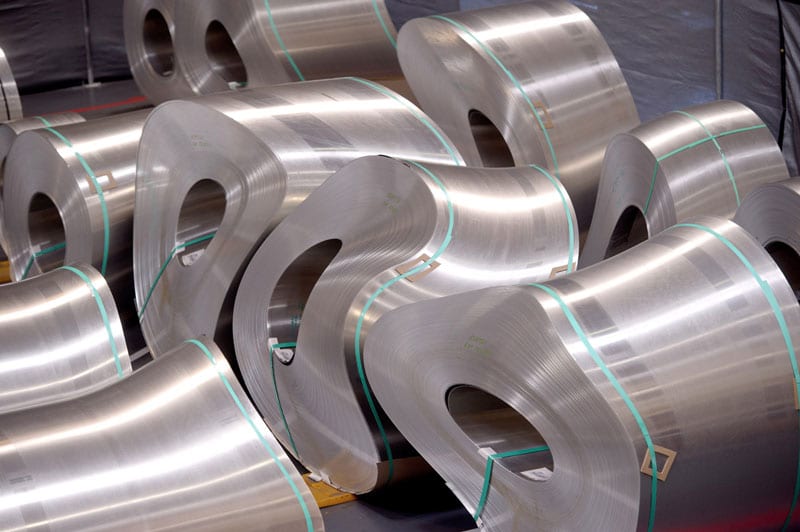Get Out Before It’s Too Late: Commodities Manipulation Revealed
For years I have been talking about the manipulation of commodity prices, including both base and precious metals.
When major banks are able to trade and participate in the commodities market, their influence can lead to prices that don’t reflect true supply and demand fundamentals.
Last week, this conflict of interest has finally come under federal scrutiny.
The Commodity Futures Trading Commission (CFTC) has now taken the first step in an examination of warehouse operations controlled by Goldman Sachs, Glencore Xstrata, the Noble Group and others and used to store vast amounts of aluminum.
The operation is claimed to have inflated the price of aluminum, which has ultimately cost consumers billions of dollars.
For a more in-depth story on this subject, please read the article:
HOW GOLDMAN SACHS AND OTHER BIG BANKS MANIPULATE THE COMMODITIES MARKET
The commission has now told these firms to retain internal documents and e-mails related to the businesses.
This comes on the heels of a recent Senate hearing last Tuesday, entitled “Examining Financial Holding Companies: Should Banks Control Power Plants, Warehouses, and Oil Refineries?”
The panel is expected to focus on how banks have taken advantage of loosened federal regulation to buy warehouses, pipelines, oil tankers and other infrastructure used to store basic goods and deliver them to consumers.
The main question is not whether banks should control the storage and shipment of commodities, but whether such activities could pose a risk to the nation’s financial system.
The answer to that is simple: Yes.
Why?
Because the big banks’ controls over commodities give them the ability to affect the prices paid by manufacturers and ultimately consumers. While there is no clear evidence of price manipulation, the recent investigations have already pushed JP Morgan to take action before its too late.
Over the past months, I have talked about the sharp decline of gold from JP Morgan’s vaults. With the recent headlines of big banks’ oligopoly in the commodity warehousing market coming under scrutiny, it seems that was enough for JP Morgan to get rid of its physical commodities business:
Via JP Morgan:
“J.P. Morgan to Explore Strategic Alternatives for its Physical Commodities Business
New York, July 26, 2013 – JPMorgan Chase & Co. (NYSE: JPM) announced today that it has concluded an internal review and is pursuing strategic alternatives for its physical commodities business, including its remaining holdings of commodities assets and its physical trading operations.
To maximize value, the firm will explore a full range of options over time including, but not limited to: a sale, spin off or strategic partnership of its physical commodities business. During the process, the firm will continue to run its physical commodities business as a going concern and fully support ongoing client activities.
J.P. Morgan has built a leading commodities franchise in recent years, achieving a top-ranked revenue position. The business has been consistently named as a top client business in Greenwich Associates’ annual client surveys and was recently named Derivatives House of the Year by Energy Risk magazine.
Following the internal review, J.P. Morgan has also reaffirmed that it will remain fully committed to its traditional banking activities in the commodity markets, including financial derivatives and the vaulting and trading of precious metals. The firm will continue to make markets, provide liquidity and offer advice to global companies and institutions that have, for years, relied on J.P. Morgan’s global risk management expertise.”
It seems JP Morgan wants to get rid of its business while it still can.
It has, after all, been stuck with the legality issues of other banks, after purchasing Bear Stearns’ problems after the crash of 2008.
Maybe this time it can sell their physical commodities business before it gets whacked with more federal investigations.
What to Expect
I would be weary of base metal prices (especially aluminum) in the near-term – especially if the banks begin to unload their physical inventories – but precious metals still look rock solid.
A few weeks ago, I mentioned that the gold market was about to turn. This has now been confirmed by the recent uptrend and strength in the gold market. Gold miners and gold stocks are finally seeing some volume to the upside, which shows promise.
We still have a month of summer left and I believe gold will climb pass $1400/oz. soon. If you believe the same, strong precious metal stocks, including all of those in our Equedia portfolio, could show some short term gains and look to move higher between now and the end of the year.
If gold can reach above $1400 and stay there, many of the better gold stocks will likely not be here much longer – especially not after the summer.














“If gold can reach above $1400 and stay there, many of the better gold stocks will likely not be here much longer – especially not after the summer.”
I’m not sure I understand this paragraph. Are you speculating that many of the better gold stocks will be bought out or do you mean they will have moved off their current low stock prices? Is this comment directed to miners and explorers alike, seniors and juniors?
Thanks,
Andrew
I am pretty sure he meant that the share prices will be moving up for both juniors and seniors.
But he stresses the better gold stocks. There’s a lot of crap out there.
Thanks, Winston, that’s pretty much my interpretation without Ivan’s clarification. Yes, lots of juniors that have undergone poor financings, ft shares, too much dilution etc. that simply won’t make it. Some potential discoveries that haven’t panned out either to the market’s expectations. BC (Telegraph Creek) is still in play in this regard. The good quality juniors in safe jurisdictions with good management is where my investments will be in gold and silver juniors (BAR-V and KOR-T are two favourites).
Banks and politicians have been in cahoots forever. I dont see how this is going to change. The banks fund the politicians, especially when theyre running a campaign to get elected.
There may be an investigation but it won’t change a thing. The banks will find another way to play with our lives, as they always have.
Asking a question about from the writer’s or other involved individuals about what is the name of 2 or 3 better gold stocks? Is it the expectation that the better gold stocks will exceed the price per ounce of gold? Having read several articles that the demand for the metal is currently exceeding production, I am saying if this be the case then why doesn’t the price of physical gold react with higher prices per ounce immediately? Is the commodity market illegally controlled to the point that prices can be manipulated by a group of entities to enrich themselves when they decide to let the gold prices rise because they let it, buy cheap, sell high? There is something that is really rotten when it comes to the precious metal markets, everyone should know that the dollar’s debasement is advancing to the point of zero value due to the Fed’s printing press necessitated to keep an artificial economy afloat. I am not comfortable with the trends showing now or that has been shown in the recent past. Something or someone will accidentally answer the questionable actions prevalent in the precious metal prices for the recent past. I am going to increase my holding of other equities that I know will grow regardless of the price of precious metals or the economy or lack thereof.
It would seem the event of Basil !!!, would provide the opportunity to stop, or put a big dent in Banks, and any other source, ability to manipulate the market for their own purposes, if there is any morality left in any of the agencies that have the obligation of overseeing the market. A. H. Wipperman.
“Maybe this time it can sell their physical commodities business before it gets whacked with more federal investigations.”
Just saw the Twitter post, seems JP Morgan is too late, now being accused of energy price manipulation.
Great comments! Glad I read all, especially the last one!
Oil-igopoly!
Most of our investments are being manipulated. It should come as no surprise that warehousing was a three card monty game. A shell game. An outright deception.
It’s up to us to guess where the manipulations will come in next. We can profit by contrarian investing against just about anything GS says.
It’s true that all of this is done under the watchful eye of the regulators and governments and this is why nothing is done until after the fact. They are allowed to do this because it is propping up a broke government.
There would be more reaction if more of the public invested. More people would be tuned into the realities and governments would be held accountable. This is why there are rules like “accredited investors”.
We the people are directly responsible for the behavior of the governments. Nothing was done about the police killing a Polish visitor on camera at the Vancouver International Air Port. Nothing will be done about the 9 bullets in the guy plus tasering the corpse in Toronto. There will be a bit of feet stamping but the din will subside and the government will get back to business as usual.
This list of wrong doing in North America is staggering when presented in totality and yet it can be passed under the noses of the people when presented one item at a time. I do not expect this nature to change. All we, the real investors, can do is wait for the next snafu.
The guy who wrote the book about how the barbarians eventually take down the elite in a repeated cycle was correct in his ideology. I wrote about how science has advanced so fast that to many it seems like magic. We all know what happened to witches in the dark ages. Are we their yet? For now it seems the armies of the elite have the upper hand. But, for how long.
It is becoming common knowledge that our politicos run a revolving door system. Just look at our own Senate. Google BC’s political scandals and read the wikki page. That’s always good for a laugh. Yet, has there been a change? Nope. They keep voting the same clowns in over and over. I guess they just like it that way.
The new trend that’s emerging is the remake of the people in the image of the corporations. I believe firmly that the destruction of our way of life is to make way for this rebirth. The politicos through big business and with them intend to remake our lives into a ultra fascism dream world. If it fails the politicos will blame the corporations and they in turn will point fingers at the governments. We will be holding the empty bag yet again.
Another nice and well-written comment Webgogs. The problem is that the average investor believes that all of this is just conspiracy, a tactic to scare investors and the retail investors.
Until these investors have been in the a market for a while, they really don’t believe these stories of manipulation.
Time is a hard lesson learned for many.
全店送料無料
The expert teachersalso moldyour child by training them to
possess efficientcommunication skills. You can ask them any questions and they will mark your work for you and go through any errors so that you fully understand them if they arise again in the future.
Keep an art bin where parents can drop off some recyclables that you have posted
on a list for art projects.
future, the researchers want to find out
whether a combination of several educated in the gastrointestinal
tract hormones can further enhance the effect of the gastric
band. Perhaps the main reason behind this though
is that you have developed a dependence on food.
Different studies have demonstrated the profits of Ginseng Panax Root Extract.